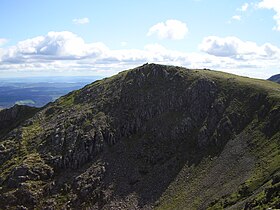Swirl How
| Swirl How | |
|---|---|

Swirl How from Great Carrs
|
|
| Highest point | |
| Elevation | 802 m (2,631 ft) (disputed) |
| Prominence | c. 112 m (disputed) |
| Listing | Wainwright, Hewitt, Nuttall |
| Coordinates | 54°23′44″N 3°07′16″W / 54.39566°N 3.12123°WCoordinates: 54°23′44″N 3°07′16″W / 54.39566°N 3.12123°W |
| Geography | |
| Location | Cumbria, England |
| Parent range | Lake District, Southern Fells |
| OS grid | NY273006 |
| Topo map | OS Landranger 97, Explorer OL6 |
Swirl How is a fell in the English Lake District. It stands between Coniston and the Duddon Valley in the southern part of the District.
The Coniston (or Furness) Fells form the watershed between Coniston Water and the Duddon valley to the west. The range begins at Wrynose Pass and runs south for around 10 miles before petering out at Broughton in Furness on the Duddon Estuary. Alfred Wainwright in his influential Pictorial Guide to the Lakeland Fells took only the northern half of the range as Lakeland proper, consigning the lower fells to the south to a supplementary work The Outlying Fells of Lakeland. Swirl How being a significant high point of the Coniston Fells therefore qualifies as one of the 214 Wainwrights. Later guidebook writers have chosen to include the whole range in their main volumes.
There is some doubt in the literature over the altitude of Swirl How. This takes on a greater significance since if it is the high point of the Coniston Fells, it is only so by a small margin. Its near neighbour, The Old Man of Coniston is within a few feet of parity. The Ordnance Survey 1:25,000 series has no spot height for Swirl How, although it is included on the 1:50,000 and the height is stated as 802m. Birkett and Wainwright also quote 2,630 ft (802 m) whilst Richards and the British Mountaineering Council 1:40,000 map quote 2,637 ft. (804 m)
Swirl How sends out ridges to the four points of the compass, each leading to further fells. Consequently, it also feeds the headwaters of four valleys.
The ridge northward to Great Carrs is named Top of Broad Slack, Broad Slack being a ferociously steep grass slope climbing out of the Greenburn valley between neighbouring crags. The ridge is a grassy plateau with a pronounced downward tilt to the west. The eastern edge is precipitous, curving around the head of Greenburn. On the journey to Great Carrs the path passes a memorial. This is the site of a wartime aircrash and bears the sad remains of a Royal Canadian Air Force Handley Page Halifax bomber. The undercarriage, together with a wooden cross and memorial cairn lies on the top of the ridge with the rest of the wreckage spread down Broad Slack. In his guidebook The Southern Fells Alfred Wainwright suggests that the plane approached from the west, failed to clear the ridge and tumbled down the other side. In fact, the wrecked aircraft came to rest on the western slope; the majority of the wreckage was subsequently pushed over the edge of broad slack by the RAF salvage crew, in order to make it less prominent and reduce the likelihood of overflying pilots spotting the wreckage and repeatedly reporting the crash. An engine and propeller from the aircraft are preserved at the Ruskin Museum in Coniston. The tilted plateau of the north ridge is triangular in plan, narrowing to a point at Fairfield in the west. This is the col between Swirl How and the ridge's western outlier, Grey Friar. To the north of this ridge are long slopes leading down to the Duddon at Wrynose Bottom.
...
Wikipedia

